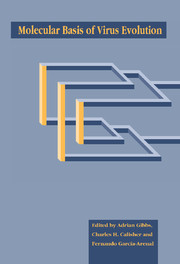Book contents
- Frontmatter
- Contents
- List of contributors
- Editors' preface
- Conference participants
- 1 Introduction and guide
- Part I The impact of viral diseases
- Part II Origins of viruses and their genes
- Part III Sources of virus variation
- Part IV Molecular interactions of viruses and their hosts
- 10 Viruses as ligands of eukaryotic cell surface molecules
- 11 The influence of immunity on virus evolution
- 12 Effect of variation within an HIV-1 envelope region containing neutralizing epitopes and virulence determinants
- Part V Viruses, hosts and populations
- Part VI Case studies of viral taxa; their systematics and evolution
- Part VII Techniques for viral systematics
- Index
11 - The influence of immunity on virus evolution
Published online by Cambridge University Press: 04 May 2010
- Frontmatter
- Contents
- List of contributors
- Editors' preface
- Conference participants
- 1 Introduction and guide
- Part I The impact of viral diseases
- Part II Origins of viruses and their genes
- Part III Sources of virus variation
- Part IV Molecular interactions of viruses and their hosts
- 10 Viruses as ligands of eukaryotic cell surface molecules
- 11 The influence of immunity on virus evolution
- 12 Effect of variation within an HIV-1 envelope region containing neutralizing epitopes and virulence determinants
- Part V Viruses, hosts and populations
- Part VI Case studies of viral taxa; their systematics and evolution
- Part VII Techniques for viral systematics
- Index
Summary
Introduction
The vertebrate immune system contains both broadly reactive and highly specific mechanisms to detect and destroy foreign proteins and nucleic acids. The specific arms of the immune system, antibodies and T cells, change extremely rapidly in response to the appearance of a new antigen, while the non-specific mechanisms of antiviral defence, principally interferons (IFN) and natural killer (NK) cells, are relatively invariant.
To escape destruction by the immune system, viruses use many tactics and strategies that allow them to survive in the individual, at least long enough to be transmitted to another host. The immune system therefore exerts a powerful selection pressure on a virus in one individual, a pressure that can sometimes be demonstrated experimentally. However, the extent to which the resulting variation in the virus is reflected in evolutionary changes in the virus population is largely a matter of inference. Recent advances in our knowledge of how the immune system, particularly the T cell, recognizes its target antigen, and the ability to sequence quickly many variants of viral genomes, should soon lead to a better understanding of the importance of immunity in affecting viral evolution.
I shall consider here the mechanisms used by viruses of vertebrates to avoid the immune system. There are three main categories of mechanism: i) changes in antigenic structure, allowing immediate escape from immune recognition; ii) changes in gene composition of the virus, usually allowing escape from non-specific viral destruction, and iii) changes in viral behaviour, such as its tissue tropism or the time-course of infection.
- Type
- Chapter
- Information
- Molecular Basis of Virus Evolution , pp. 150 - 164Publisher: Cambridge University PressPrint publication year: 1995
- 1
- Cited by



